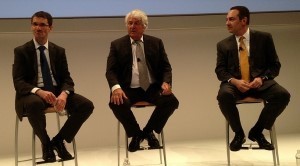The second day of the giant SAPPHIRENOW conference took the Run Simple message one notch higher with SAP executives and customers providing more examples of simplifying applications landscape through sustained innovation.
The three-day conference attracted more than 25,000 attendees with many more tuning in to its live webcasts, providing a lift to SAP’s near-term prospects as the vendor seeks to accelerate growth in order to reach its revenue target. By 2017 SAP aims to secure about $30 billion in total revenues including $4.7 billion in total Cloud sales, compared with $22.7 billion and $1.25 billion in 2013, respectively.
At the vision level, SAP chairman Hasso Plattner continued to trumpet the advantages of using its in-memory database product SAP HANA to eliminate aggregates, or redundancy, thus boosting system performance especially in running reports as well as querying and other applications.
That led to further discussion of such benefits with Clayton Christiansen, the Harvard Business School professor, chiming in and querying how the elimination of aggregates could be extended to helping companies structure their operations differently since the normal org chart may no longer be effective anymore as many of the critical tasks could be handled or outsourced by small teams that can access information faster and gaining insights quicker.
In other words, with the explosive use of mobile devices and an onslaught of social media data, employees can access and crunch customer data on a real-time basis, thus identifying and addressing their needs faster than ever simply by collaborating with a small team of colleagues all running on a turbo-charged database machine like SAP HANA.
At the product level, the task of simplification took on a different dimension as Bernd Leukert, SAP new product chief, outlined its roadmap specifically on positioning SAP Business Suite as the common core for both on-premise and Cloud applications.
Through the remainder of 2014, new enhancements will be delivered to its inventory management, logistics and other modules allowing customers to drive greater business value. The first product will be Simple Finance, which again leverages SAP HANA to deliver business insights on a real-time basis because all transactional data are being done within the in-memory database. That fares well against the conventional practice of loading and unloading data from different sources, putting them through best-of-breed BI tools and ultimately generating customized reports that could take customers days or weeks to compile.
All the enhancements will come in handy for companies striving to gain a competitive edge with the use of SAP HANA as some kind of pocket calculator – in the form factor of an iPad of course – that can tabulate their daily results or even hourly receipts at a moment’s notice.
It’s that kind of speed and convenient delivery as well as the simplification of applications landscape that has convinced companies such as Burberry to standardize on SAP Business Suite, or some other rendition of it in the future, all of which will be powered by SAP HANA.
At the conference, the upscale retailer announced that it would replace its legacy SAP and Oracle applications with SAP Business Suite running on SAP HANA. In addition Burberry would take on products such as Hybris for eCommerce. Instead of dealing with Oracle, SAP and Salesforce.com for sales force automation, Burberry now only needs to support the latter two as its major back-office and front-office platforms, respectively.
During a separate session, Falko Lameter, manager of IT operation of Germany-based air system manufacturer Kaeser Kompressoren, echoed the view of Burberry by stating the benefits of standardizing on SAP Business Suite with the use of SAP HANA to pursue IT innovation, while strengthening business value.
Lameter said with the use of SAP Business Suite primarily for CRM on SAP HANA, system management has become easier while business processes can be handled faster in cases like the crunching of one million measurements per second during its preventive maintenance procedures. Because of such benefits, Lameter expects Kaeser, already a big SAP shop, to invest further in SAP applications such as Ariba for supplier management and SuccessFactors for HCM over the next five years.
Despite such optimism, the near-term prospects will depend on whether the majority of SAP customers are going to be following SAP’s roadmap, which appears to be closely intertwined with SAP HANA more than ever.
To that end, Leukert’s keynote highlighted the growth of SAP HANA, saying that the number of SAP HANA customers has reached 3,376, compared with 3,200 in the first quarter of 2014 and 1,300 a year earlier. About 1,000 of these customers have also started running SAP Business Suite on SAP HANA. Currently SAP Business Suite has about 30,000 customers.
Following the keynote, Steve Lucas, president of SAP Platform Solutions, upped the ante by unveiling SAP Platform As A Service offering that is based on SAP HANA, helping developers rapidly put their applications on the platform under Cloud subscriptions that are priced for a few hundred dollars a month.
Lucas said scores of customers have already done that by developing their new applications on the HANA platform with the underlying assumptions that their products could be extended easily to SAP Cloud applications including Business Suite on SAP HANA Enterprise Cloud as well as SuccessFactors and Ariba, the latter two of which have also been optimized for SAP HANA.
The next question is whether SAP HANA, or its variants from SAP HANA Enterprise Cloud for rapid deployment options to HANA Cloud Platform – the PaaS release for developers – will be enough to drive Cloud adoptions on a massive scale.
This is where things could get a lot less simple than what SAP is portraying. For one thing, SAP continues to be ambivalent about the intrinsic value of multi-tenant deployment of Cloud applications, an approach that has been widely adopted by fast-growing companies such as Workday, Zendesk as well as SAP’s own SuccessFactors to scale out massively in a compressed time frame.
For instance, Zendesk, which specializes in Cloud-based customer service applications, has been able to achieve a critical mass of nearly 39,000 customers by successfully leveraging a scalable multi-tenant platform in the first seven years of its history since its founding in 2007. That is a steeper ramp than Cloud pioneer Salesforce.com, which saw the growth of its customer count to 13,900 in its first seven years.
During a Q&A session, SAP chairman Plattner squarely dismissed the benefits of multi-tenant delivery of its enterprise applications, primarily those that deal with mission-critical functions like supply chain and financials. Plattner evoked a heated debate over the merits of multi-tenancy with Lars Dalgaard, former CEO of SuccessFactors after it was bought by SAP in 2012. To this date, Plattner’s position, though not unique, remains that SAP’s biggest customers – fearing unnecessary business disruption – would still prefer deploying their applications either in a private cloud setting or as managed services, all without the intrusion of continuous updates commonly found in other Cloud applications.
What that implies is that there may well be a convoluted environment within a hybrid applications landscape among its customers – meaning that some customers may run multi-tenant applications like SuccessFactors, while leaving the use of SAP Business Suite either behind their firewall or in a single-tenant mode that does not get updated continuously by SAP.
Thus the added complexity to a supposedly simplified application landscape raises more questions than answers in the context of SAP’s new slogan of Run Simple.






